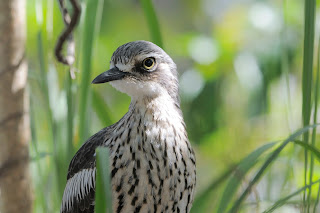
Eastern Curlews, Bar-tailed Godwits are but two of the many Migratory Waders which visit the Gold Coast Broadwater. Curlew Island and Curlew Banks are of international significance and have no official protection. This blogsite contains detailed information to help everyone understand the importance of this treasure.
Wednesday 20 December 2017
Little Terns at Jumpinpin. These are our smallest tern and there are only a few populations in SE Queensland. I did a series of photo scans and this showed there were 340 present here. What a great sight.
Their breeding site in a remote location, some distance away, showed sign of activity. Please keep clear of these areas as their eggs area easy to walk on and crush.
Sunday 10 December 2017
Tuesday 5 December 2017
Two years ago the rare Beach Stone Curlew bred on Curlew Island. There is only one known pair in the Broadwater. They brought out two chicks but both became entangled in discarded fishing line. The fishing line wraps around the limb and cuts off circulation. The birds often die as a result. Our bird hero Roley Goonan managed to catch one early and free it. The other was caught much later and dispatched to Currumbin Bird Hospital. I am not sure that it ultimately survived as I only saw a trio from then on. I haven't seen the birds for over a year now and had been concerned about their survival.
Yesterday I was doing a weed survey with Paul Donatiu form 'Heathy Waterways' and he spotted a bird. It turned out to be the family of three Beach Stone Curlews. I hope they make it for another year and years after that.
On this trip we disturbed a female darter. On the photo it looks as though it has shark hook in its bill.
If you must fish! Fish responsibly.
Tuesday 28 November 2017
Last week, when I arrived on Curlew Island, in the centre of the Broadwater near the Grand Hotel. This junior Willy Wagtail, thought I was mum and followed me around begging for food.
Here is what I found there that day:-
Whimbrels 88, Bar-tailed Godwits 74, Eastern
Curlews 46, Curlew Sandpiper 1, Pied Oystercatchers 6, Australian Pelicans 62, Crested
Terns 43, Gull-billed Terns 19, Caspian Tern 1, Silver Gulls 50, Chestnut Teal
1, Little Black Cormorants 6, Pied Cormorant 1, Whistling Kite 1, Brahminy Kite 1, Welcome Swallows
10, Willy Wagtail 1, Torresian Crow 2. Total Birds 413. Species 18.
It is a pity most people don't realise how rich our Broadwater is.
Wednesday 22 November 2017
Tuesday 21 November 2017
Monday 6 November 2017
Many people have seen a Curlew but the question is which one have you seen. There are four birds which visit the Gold Coast and have Curlew in their name. Some are common and others are rare. The Eastern Curlew is critically endangered, one of 13 birds on the national list. The Broadwater has large numbers of them - one of the few places in the world where this is the case.
Follow this link to sort them out
Link: Our Curlews
Thursday 12 October 2017
About Curlew Island
Home of the Eastern Curlew.
This island is the most significant site in the whole of the Gold Coast Broadwater for shorebirds. "Curlew Island" is located on "Curlew Banks" at the southern end of the Gold Coast Broadwater.
Curlew Island is directly opposite the Grand Hotel on Marine Parade. It is a short boat ride from the mainland. Most people overlook the shorebirds which live here, as they merge into their environment. However they are clearly visible with a scope or a good pair of binoculars.
Between 100 and 400 shorebirds gather here at high tide. The most common shorebird species seen here are Eastern Curlews, Bar-tailed Godwits and Whimbrels.
Usually these are accompanied by many other species such as Pelicans, Gulls and Terns.
The link below takes you to the pdf book which Bob wrote about the island. It is best viewed on a computer.
The book was completed in 2014 and it is a record of what he saw and photographed over a two year period. He has also included a section about birds found along the 'Federation Walk' on the Spit.
Click on the link below to view the book.
Birds of Curlew Island and the Federation Walk
Subscribe to:
Posts (Atom)












